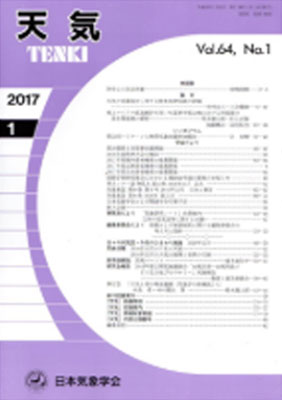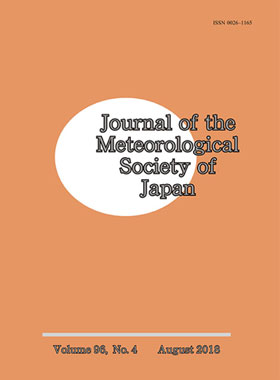Guide for Authors
Guide for Authors and template files
Content
Aims and Scope
SOLA (Scientific Online Letters on the Atmosphere) is a peer-reviewed, Open Access, online-only journal. It publishes scientific discoveries and advances in understanding in meteorology, climatology, the atmospheric sciences and related interdisciplinary areas. SOLA focuses on presenting new and scientifically rigorous observations, experiments, data analyses, numerical modeling, data assimilation, and technical developments as quickly as possible. It achieves this via rapid peer review and publication of research letters, published as Regular Articles.
Published and supported by the Meteorological Society of Japan, the journal follows strong research and publication ethics principles. Most manuscripts receive a first decision within one month and a decision upon resubmission within a further month. Accepted articles are then quickly published on the journal’s website, where they are easily accessible to our broad audience.
Journal Policies
SOLA upholds the highest scientific and publication ethics standards and the journal’s various policies are detailed below. SOLA follows the Committee on Publication Ethics (COPE) guidelines when dealing with any cases of misconduct or dispute.
Acceptance criteria
SOLA is a rapid review, rapid publication journal that publishes articles meeting the basic criteria for scope, length, ethical standards, English standards and clarity of expression. In addition, articles must be scientifically rigorous and technically proficient, with methods and analyses that are appropriate to the study being reported.
Furthermore, all manuscripts reporting original research should:
- contain observations, experiments, data analyses, numerical models, or theory concerning the basis and application of meteorology, climatology, and atmospheric sciences
- contain new findings with scientific value or technical developments, obtained by the authors themselves
- have logically explained conclusions
- be written in clear and concise English.
Authorship
By submitting to SOLA, all authors undertake that they have agreed to the author list. Any amendments to the list (such as changing the order, or adding or removing authors) after submission must be approved by all authors and the Editor. In addition, all authors must have contributed substantially to the work; have agreed to be accountable for their contributions to the work; be able to identify the co-authors responsible for each part of the work; have confidence in the integrity of the work; and have reviewed and approved the final manuscript. Contributors who do not qualify for authorship should be included in the Acknowledgements section.
Duplicate submission and unoriginal material
Authors must not have submitted their manuscript to another journal before the Editorial Committee makes the final decision on its suitability for publication in SOLA. If there is an indication of duplicate submission, the Editorial Committee will investigate further and will reject immediately in cases where duplicate submission is confirmed.
The journal screens accepted articles for any unoriginal material before publication using the iThenticate service (ithenticate.com).
Authors may freely submit their manuscripts to another journal after withdrawal or rejection from SOLA.
Author warranties
When submitting a manuscript to SOLA, the author(s) warrant that:
- The article is original and is not under consideration for publication in any other journal.
- The author(s) are the sole author(s) and sole owners of the copyright in the manuscript, and the manuscript does not infringe on existing copyright or other third-party rights. If material from other sources is included in the manuscript, then appropriate permissions have been obtained.
- Due care has been taken with the preparation of the manuscript to ensure its integrity, that the facts presented are true and accurate, and that nothing in the manuscript is obscene, defamatory or libellous or violates any right of privacy.
Image and data integrity
Images, especially graphics files, which are included in a manuscript for review should not be processed except for necessary guides for readers (e.g., labels or arrows, etc.). If manipulation is necessary, it should be applied to the entire image and any changes should be noted in the manuscript.
Any data associated with images or other aspects of the manuscript must be retained by the authors and provided upon request.
Reproducing copyrighted material
If a manuscript contains a figure or other material from another source, the authors must provide documentation of the permission to re-use from the copyright holder. SOLA is not responsible for obtaining these permissions and authors warrant that they have the rights, or have obtained them, for all material in their manuscripts.
Availability of data and materials
SOLA encourages authors to include the data underlying their work as Supplementary Material. These data, which must be under 50MB, may describe observations, experiments, modeling or analyses and may take the form of databases, simulations, movies, large figures or as otherwise appropriate.
Conflicts of interest
SOLA strives for transparency around any real or perceived conflict of interest regarding articles published in the journal. A conflict of interest exists when judgement about one interest might be influenced by a secondary interest. This can extend to any financial consideration, academic competition and rivalry, personal rivalry or intellectual incompatibility. Conflicts of interest extend to all participants in the peer-review process: authors, reviewers, Editors, and Editorial Committee members.
Any real or perceived conflicts of interest by any of the participants in the publication process must be considered while undertaking their respective tasks for SOLA. When relevant, they should be declared clearly to the relevant person.
Authors should declare in their cover letters whether they have any conflicts of interest (financial or otherwise). If so, the Editor will determine the most appropriate course of action. Reviewers are asked to declare any potential conflicts of interest and recuse themselves if the potential for bias exists.
The Editors and Editorial Committee undertake to declare their conflicts of interest when handling manuscripts for publication.
Confidentiality
SOLA maintains the confidentiality of all submitted and rejected manuscripts. By submitting to the journal, authors agree to keep all correspondence about their manuscript (from the Editorial Office, editors and any others) confidential.
SOLA uses single-blind peer review, so the identities of reviewers are not revealed. Journal staff will not disclose a reviewer’s identity unless the reviewer requests it. As part of their responsibilities, reviewers undertake to maintain the confidentiality of manuscripts to which they have access.
Editorial and peer review process
Upon submission, the Editorial Office ensures that the manuscript complies with the basic length and figure/table number requirements (see other sections for further details). For compliant manuscripts, the Chief Editor assesses whether the manuscript should be sent for peer review (and may often ask an Editor for assistance where necessary). If the manuscript is deemed suitable for peer review, the Chief Editor assigns an Editor who is responsible for handling the peer-review process.
The Editor selects and assigns reviewers who are asked to return their reports within 2 weeks. When reports are received, the Editor assesses the manuscript and the reviewers’ comments, and advises the authors of their decision: revise or reject.
If invited to resubmit a revised version, authors must do so within two weeks of the decision notification date. If the Editor judges that the manuscript needs major revision and it would take more than two weeks to revise, the Editor will usually reject it. However, the Editor may also recommend that the authors resubmit the manuscript as a new manuscript after sufficient revision is completed. Authors should note this in the cover letter of any resubmission of a rejected manuscript.
Manuscripts rejected as being not suitable for the journal or judged to be unlikely to be able to be sufficiently revised will not be reconsidered and should not be resubmitted.
The review process for corrigenda is simpler. The Chief Editor or the previously assigned Editor are responsible for assessing the merits of each corrigendum. The Editor may consult the reviewers or the Editorial Committee members during the review process.
Referee suggestions
Authors are requested to provide the Editor in charge with suggestions of up to 5 potential reviewers, with their e-mail addresses, during the ScholarOne submission process. The Editor in charge reserves the right to determine the final selection of manuscript reviewers.
Appeals
Authors who believe that errors have been made during the editorial review process may contact the Chief Editor and lodge an appeal. Authors must provide specific evidence of a misunderstanding or mistake by a referee or editor. Appeals will be considered carefully by the Chief Editor, whose decision is final.
Corrigenda and Retractions
SOLA supports the correction of errors in the published literature. If published articles are found to contain significant errors, the Chief Editor and Editorial Committee will determine whether a Corrigendum or a Retraction is most appropriate.
Retractions are used for articles that have been found to have invalid or unsound results or conclusions, or for cases in which authors are believed to have breached research or publication ethics.
Corrigenda are used to correct mistakes in the article that were made by the authors or during the production process, respectively. When preparing Corrigenda , include the title, author names and their affiliations. The title should follow this convention: “Corrigendum: Your original article title”. No Abstract is required.
The main text of Corrigenda does not need to be divided into sections. However, if you do require the use of separate sections, please follow the instructions for Regular Articles below. For other elements, please follow the relevant instructions for Regular Articles as described elsewhere within this document.



 RSS feed of SOLA latest issue
RSS feed of SOLA latest issue
